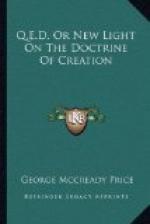If cells did not maintain their ancestral characters in a very remarkable way, what would be the use of grafting a good kind of fruit onto a stock of poorer quality? The very permanency of the grafts thus produced is proof of the persistency with which cells reproduce only “after their kind.”
IV
How can we fail to see the bearings of these facts on the doctrine of the transformation of species among ordinary plants and animals, which are merely isolated and self-contained groups of cells? Do not these facts constitute strong presumptive evidence that among animals and plants, though there may be variation in plenty within certain limits, perhaps within even much wider limits than used to be thought possible, yet among these distinct organisms, little and big, new forms develop only after their ancestral type, in full accord with the record given in the first chapter of the Bible?
But we are now prepared to examine in more detail the facts as now known to modern science regarding “species” of plants and animals.
V
WHAT IS A “SPECIES”?
I
We have seen that there is no way to account for the origin of matter, of energy, or of life, except by postulating a real Creation.
We have seen that cells continue to maintain their identity, and reproduce only “after their kind.”
We must now deal with the higher forms of cell aggregates, which we call plants and animals. It has long been held that these at least are mutable, that one kind of plant or of animal may in the course of ages be transformed into a distinctly different type; and of late years there has accumulated a very voluminous literature dealing with the various intricacies of this problem of the origin of species. How can we deal with such a large subject in a brief way? It seems best to confine our attention in this chapter to an attempt to answer the question, What is a species? and are “species” natural groups clearly delimited by nature?
II
The term “species” was at first used very loosely by scientific writers. It meant very little more than our vague word kind does at the present time. Not until the time of Linnaeus (1707-1778) did the term acquire a definite and precise meaning. The aphorism of the great botanist, “species tot sunt diversae quot diversae formae ab initio sunt creatae”—“just so many species are to be reckoned as there were forms created in the beginning,”—was at least an attempt to use the term in a well-defined sense. Of course, this definition assumed the “fixity” of species; but with the wide prevalence of the views of Darwin and his followers the term “species” has fallen into disrepute, and is now regarded by many as only an artificial




